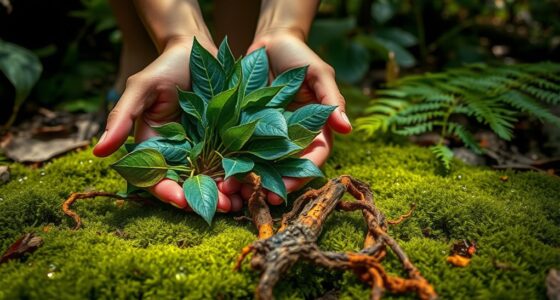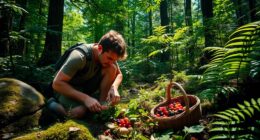Foraging for invasive species can be a great way to help the environment while enjoying tasty, edible plants. By properly identifying and sustainably harvesting invasive plants like Japanese knotweed or autumn olive, you can reduce their spread and support native ecosystems. Responsible foraging prevents seed dispersal and encourages native plant recovery. If you keep exploring, you’ll discover how to do this safely and effectively, making a positive impact on your local environment.
Key Takeaways
- Foraging invasive species like garlic mustard and Japanese knotweed helps control their spread and reduces their ecological impact.
- Proper identification and sustainable harvesting prevent further seed dispersal and protect native plant populations.
- Community involvement in invasive plant removal promotes ecosystem recovery and enhances native biodiversity.
- Using invasive plants for food supports ecological management without relying on chemical control methods.
- Responsible foraging practices, including cleaning tools and avoiding treated areas, ensure environmental safety and effectiveness.
Understanding the Ecological Impact of Invasive Plants
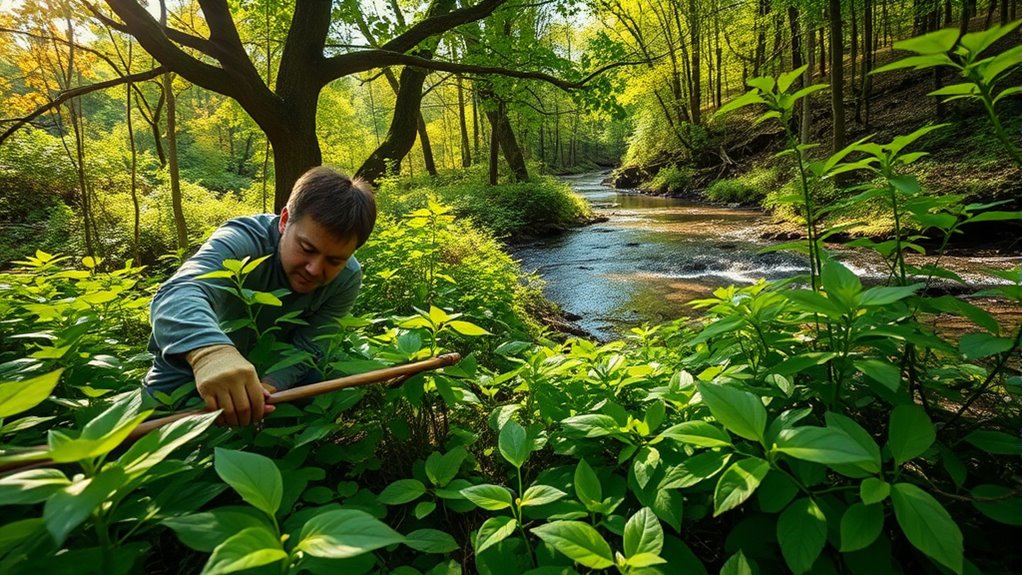
Invasive plants substantially alter native ecosystems by outcompeting local flora and reducing biodiversity. When invasive species like Japanese knotweed or garlic mustard invade, they form dense thickets that block sunlight, disrupting native plants’ growth. This habitat alteration affects wildlife that depends on native flora, causing ecosystem disruption. The ecological impact extends to seed dispersal, as invasive plants often spread rapidly through prolific seed production, making control methods challenging. These plants threaten biodiversity by replacing native species and decreasing habitat quality. Managing invasive plant populations demands significant resources because their aggressive growth undermines native flora’s resilience. Understanding this ecological impact highlights the importance of invasive plant management, which aims to protect ecosystems from further habitat alteration and restore native plant communities. Additionally, a free online tool can help identify and monitor invasive species, aiding in early detection and control efforts. Implementing effective control strategies can also help mitigate the spread of invasive plants and support ecosystem recovery.
Identifying Edible Invasives and Their Culinary Uses

Have you ever considered turning invasive plants into a culinary resource? Many invasive species, like garlic mustard, Japanese knotweed, and autumn olive, are edible invasives with valuable culinary uses. Garlic mustard has garlic-flavored leaves, roots, and seeds, especially in early spring, perfect for foraging. Japanese knotweed offers tender shoots that taste similar to rhubarb, ideal for desserts or sauces. Autumn olive produces sweet berries that can be eaten fresh or used in jams. When identifying these invasive plants, proper recognition is essential, and avoid harvesting from chemically treated or flood-prone areas. Using these invasives as a control method not only reduces their environmental impact but also provides nutritious, native plant alternatives. Incorporating edible invasives into your diet supports ecological health while enjoying creative culinary uses. TikTok is a popular platform where foraging tips and recipes for invasive species often go viral, helping to spread awareness and sustainable practices. Additionally, understanding invasive plant identification techniques is crucial for safe and effective foraging.
The Role of Foraging in Managing Invasive Species

| Invasive Species | Foraging Practices | Ecological Benefits |
|---|---|---|
| Garlic mustard, Japanese knotweed, autumn olive | Proper identification and sustainable harvesting | Reduces invasive populations without harming native plants. Engaging in seed-based diets knowledge helps inform sustainable harvesting practices, ensuring that foraging remains environmentally responsible. |
| Promotes invasive plant control | Harvesting helps prevent spreading seeds | Supports ecological restoration and native ecosystem recovery. Additionally, understanding the horsepower of electric dirt bikes can inspire innovative approaches to managing larger invasive removal efforts. |
| Complements other management methods | Focus on invasive plant removal with responsible practices | Enhances ecological management efforts |
| Low-impact, effective tool | Involves community participation | Contributes to long-term invasive species management |
Challenges and Strategies for Responsible Invasivorism
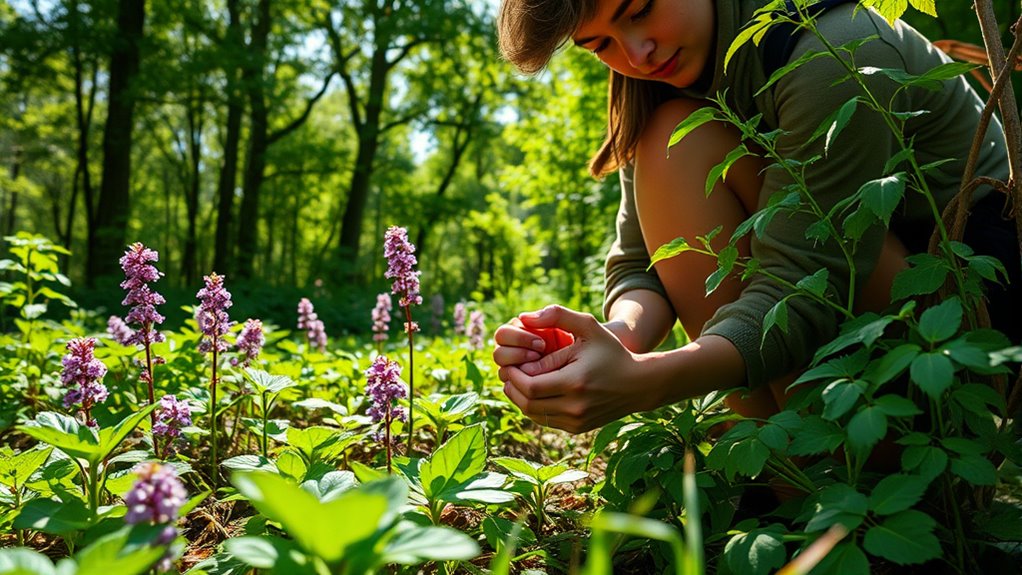
Responsible invasivorism presents several challenges, primarily ensuring that foragers can accurately identify invasive species and assess environmental conditions before harvesting. Proper plant identification and environmental awareness are vital to avoid harming native plants or disrupting ecosystems. You must follow effective harvesting techniques, such as cleaning gear and disposing of plant fragments properly to prevent spreading invasive species. For example, using appropriate tools can help minimize damage to surrounding native vegetation. Additionally, understanding GMC tuning principles can aid in recognizing signs of plant stress or damage caused by invasive species, which is crucial for making informed harvesting decisions. Recognizing symptoms of invasive species is essential for successful invasivorism and environmental protection. Foraging safety involves staying away from treated areas, flood zones, or chemical-laden sites. Regional regulations may restrict the transport or possession of certain invasive species, so understanding local laws is essential. Combining responsible invasivorism with other control methods enhances ecological impact, but always prioritize accurate identification and awareness to prevent unintentional ecological harm. This careful approach safeguards ecosystems while promoting sustainable foraging practices. Additionally, being familiar with onboard experience aspects such as cruise logistics and safety protocols can improve overall awareness of environmental and operational considerations.
Supporting Ecosystem Restoration Through Sustainable Practices
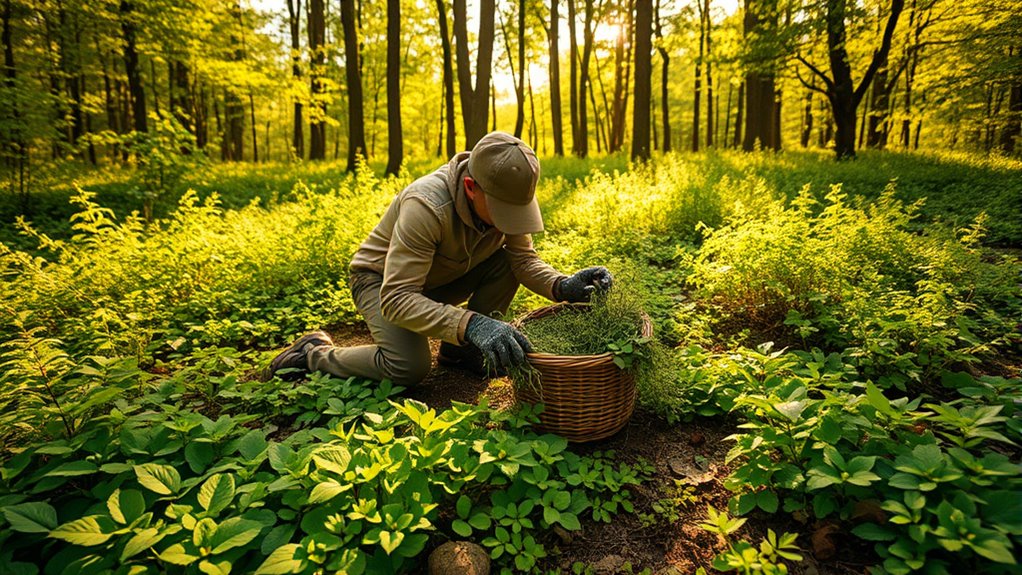
By harvesting invasive species responsibly, you can actively contribute to restoring native ecosystems. This sustainable harvesting diminishes invasive populations, allowing native plants to reclaim their space. This approach supports verified eco-friendly practices that promote ecological balance. Focus on proper identification to avoid ecological harm and prevent invasive seed dispersal. Incorporate invasive plant management techniques that support ecosystem restoration and promote native biodiversity. You can:
- Remove invasive plants like garlic mustard and Japanese knotweed
- Support native plants through targeted harvesting
- Educate others and foster community involvement
Engaging in dynamic communication exercises with local volunteers can enhance collaboration and increase awareness about invasive species management. These efforts ensure invasive species don’t dominate, minimizing ecological harm. Using solar-powered security cameras can help monitor invasive plant areas and deter illegal removal activities. Additionally, implementing appropriate harvesting tools can improve efficiency and reduce impact on surrounding native flora. Combining foraging with other management strategies enhances control and helps rebuild resilient ecosystems. Your role in invasive plant management directly impacts native biodiversity, creating healthier, balanced environments for future generations.
Implementing community-based monitoring methods can further optimize invasive species control efforts.
Frequently Asked Questions
How Does Foraging Help the Environment?
You might wonder how foraging helps the environment. When you harvest invasive species, you reduce their numbers, slowing their spread and easing their ecological impact. This also gives native plants a chance to thrive, restoring balance. Plus, by foraging instead of using chemicals, you support healthier soil and water. Your efforts contribute to protecting biodiversity, saving money on control costs, and promoting a more sustainable, resilient ecosystem.
How Can Invasive Species Be Beneficial to the Environment?
Invasive species can be beneficial because they provide new food sources, support biodiversity, and help control pests. You can harvest and eat them, turning ecological threats into resources. By doing so, you reduce their spread, lessen competition with native plants, and promote ecosystem balance. Proper identification and responsible harvesting guarantee you maximize environmental benefits while preventing further invasion. This way, invasive species become allies in restoring healthy, resilient ecosystems.
What Are Some Environmental Solutions to Invasive Species?
You can help address invasive species by supporting environmental solutions like mechanical removal, chemical treatments, and habitat restoration. Promote invasivorism by consuming invasive plants, which reduces their spread naturally. Educate others about responsible foraging and disposal, and support biological control methods that use natural predators carefully assessed for ecological safety. Using integrated strategies, you’ll help control invasive impacts, restore native ecosystems, and protect biodiversity effectively.
Can We Eat Our Way Out of Invasive Species?
Can we really eat our way out of invasive species? It’s tempting to think so, but the truth is more complex. While foraging invasive plants like garlic mustard can help reduce their numbers, it’s not a silver bullet. You play a vital role by properly harvesting and promoting awareness. Your efforts, combined with other control methods, can make a real difference in restoring native ecosystems.
Conclusion
By foraging responsibly for invasive species, you become part of the solution. Imagine removing Japanese knotweed from local parks while preparing a delicious pesto—helping restore native plants and reducing environmental harm. Your efforts can make a real difference, turning invasive threats into opportunities for sustainable food sources. So next time you’re outdoors, consider identifying and responsibly harvesting invasives—your actions can help protect ecosystems for future generations.






